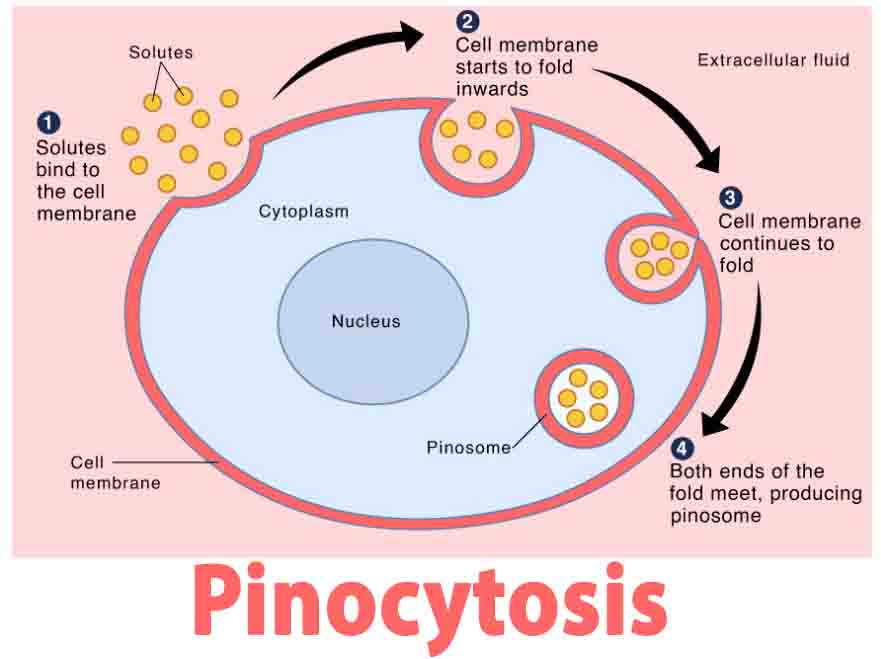Pinocytosis Definition
Pinocytosis is the process by which a cell absorbs small particles from the outside and brings them inside. Pinocytosis means “drinking from cells” in Greek. During this process, the cell surrounds particles and then pinches off part of its membrane to enclose them in vesicles, which are small spheres of membrane. Extracellular fluid (ECF) is usually ingested through this process.
Function of Pinocytosis
This is a form of endocytosis known as pinocytosis. During endocytosis, particles are engulfed by the membrane of a cell. There are also two types of endocytosis: phagocytosis (“cell eating”), in which particles are taken into a cell by binding to receptors, and receptor-mediated endocytosis, in which particles are taken into a cell by binding to receptors.
Pinocytosis is the process by which small particles of substances in the ECF are absorbed into the cell. An active transport process requires energy on the part of the cell (as opposed to a simple diffusion process).
It is non-specific; it is triggered by the presence of certain substances outside the cell such as amino acids or certain ions, but results in the absorption of many different substances by the cell at the same time, including water and various solutes like sugars and proteins.
Steps of Pinocytosis
- Cell membrane receptors bind to inducer substances, such as proteins. This differs from receptor-mediated endocytosis in that pinocytosis takes in a variety of molecules rather than just one.
- Around the part of the ECF that is going to be absorbed into the cell, the membrane forms a small open-ended pocket, or invagination.
- At the open end of the invagination, or “pinch off”, the cell membrane begins to reconnect.
- Invagination is fully pinched off by the cell membrane, forming a vesicle. The sphere is formed by the membrane of the cell surrounding the materials taken in by the cell. As molecules are transported, it prevents them from disrupting the rest of the cell.
- It is eventually possible for other parts of the cell to use the molecules contained within the vesicles.
Examples of Pinocytosis
In many cases, pinocytosis plays a major role among the cells of the body, but there are some situations where pinocytosis is particularly important. This process is used by microvilli in the gut to absorb nutrients from food.
During pinocytosis, kidney cells separate nutrients and fluids from urine that will be expelled from the body. Aside from that, it is also used by human egg cells in order to absorb nutrients prior to fertilization.
Types of Pinocytosis
The size of the vesicle that is formed determines whether pinocytosis is macropinocytosis or micropinocytosis. Micropinocytosis forms vesicles that are even smaller, about 0.1 m in length, formed from the tiniest dents in the cell membrane. Macropinocytosis vesicles are about 1-2 m in length (0.0001-0.0002 cm), whereas macropinocytosis vesicles are about 1-2 m long (0.0001-0.0002 cm).
Differences between Pinocytosis and Phagocytosis
Despite their similarities, pinocytosis and phagocytosis differ in several important ways. Unlike pinocytosis, phagocytosis allows larger particles, such as bacteria, to be absorbed. Pinocytosis involves the ingestion of liquids and solutes, while phagocytosis involves the ingestion of solids.
A pinocytosis occurs when the contents of the vesicles are emptied directly into the cell, but a phagocytosis does not occur since the contents of the vesicles are too large. For the contents of vesicles to be broken down, lysosomes must combine with them. In pinocytosis, this process does not take place.
Related Biology Terms
- An invagination of the cell membrane allows a cell to take in particles.
- Phagocytosis is the absorption of large particles by cells, such as bacteria.
- An invasion occurs when a structure (in this case, a cell membrane) folds back or turns inside out to create a pocket or cavity.
- Nutrients and waste products are transported by vesicles, which are small spheres of membrane inside the cell.

